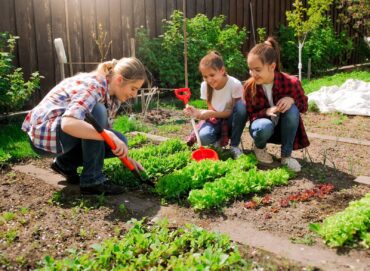 Growing your garden is a rewarding experience, and it’s even more rewarding when you can include your children in the gardening process. While your children might not be too keen on weeding, there are a number of ways to engage them with gardening. Simple actions like decorating the garden with artwork and learning about gardening science will have a large impact on engaging your children with gardening.
Growing your garden is a rewarding experience, and it’s even more rewarding when you can include your children in the gardening process. While your children might not be too keen on weeding, there are a number of ways to engage them with gardening. Simple actions like decorating the garden with artwork and learning about gardening science will have a large impact on engaging your children with gardening.
1. Read books about gardening.
Reading is one of the easiest ways to help your children take an interest in a new subject, and thankfully, there are a number of informative gardening books that will delight young readers. You can incorporate gardening books to read before your child takes a nap or goes to bed, or for afternoon entertainment. Visiting your local library will allow your children to choose gardening books that pique their interest and provide more information on the gardening subject.
2. Plant items that your children will enjoy.
If you plant items that you know your children will enjoy, they will be more involved throughout the gardening process. If your children love berries, you could plant strawberry plants or blueberry bushes, or you could plant pumpkins for your family to carve during the fall. If your children will enjoy the result of their gardening efforts, they will be much more engaged with the gardening process.
3. Make the gardening process fun.
Throughout the gardening process, you will have to tackle several hard tasks like weeding and mulching, but if you make gardening fun, it will be a more enjoyable experience for everyone involved. Perhaps you could bring a portable speaker and play music, or you could arrange for a special treat like cold lemonade once you’ve finished gardening for the day. Gardening will also be more pleasant for your children if you have child-sized tools for them to use and cushions to make gardening more comfortable.
4. Decorate the garden with artwork.
As a way for children to take ownership of the garden, have them decorate the garden with artwork. They could paint rocks for you to display or create nameplates for the different types of plants and flowers in your garden. You could even have them draw pictures of your garden and frame them by where you keep your gardening supplies. For younger children who might not be able to participate in all of the gardening activities, this is a great way to get them interested in the gardening process.
5. Incorporate gardening aspects into your daily activities.
If you can incorporate gardening aspects into your daily activities, your children will be surprised at how many ways gardening impacts their daily routine. As you check the weather each day, you can discuss how the weather will affect your garden and if you need to do anything. At breakfast, you can use jam made from your garden’s fruit, and if you take pictures of your garden, you can display them around your house.
6. Learn about the science behind gardening.
Learning about the science behind gardening is important because it gives children a better understanding of how a garden works. Children should understand about photosynthesis, the process of how plants grow, but they should also know how creatures such as bumblebees and earthworms are vital to a garden’s success. If your children understand more about the gardening process, they will be more likely to continue growing their garden skills.
Engaging your children with gardening is important because it helps them take ownership of the garden and encourages them to participate in gardening activities. Developing a love for gardening won’t happen overnight, but by engaging your children in the gardening process, it’s a nice start.























